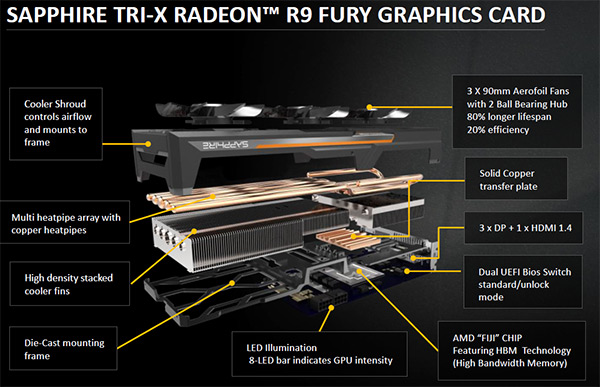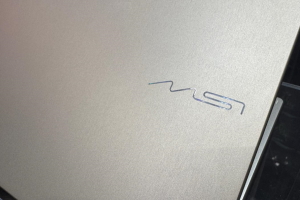AMD Radeon R9 Fury: la seconda scheda con GPU Fiji

Al debutto le prime due schede Radeon R9 Fury di Sapphire e AMD, che abbinano le peculiarità della GPU Fiji alla tecnologia HBM per la memoria. Il tutto condito dall'utilizzo di tradizionali sistemi di raffreddamento ad aria al posto di quello a liquido integrato nelle proposte Radeon R9 Fury X.
di Paolo Corsini pubblicato il 10 Luglio 2015 nel canale Schede VideoAMDRadeonSapphireASUS
Due nuove schede Radeon R9 Fury
Sono passate poco più di 3 settimane dalla presentazione della scheda video AMD Radeon R9 Fury X; quest'oggi giunge il momento del debutto della seconda scheda basata sulla nuova architettura che AMD rende disponibile sul mercato. Parliamo della proposta Radeon R9 Fury, che AMD rende disponibile attraverso due schede custom sviluppate rispettivamente da Asus e Sapphire. Non sappiamo se altri partner AIB di AMD presenteranno proprie schede Radeon R9 Fury, ma alla luce delle informazioni fornite da AMD non sembra essere questo il caso almeno per il momento.
A differenziare queste schede da quelle Radeon R9 Fury X troviamo il sistema di raffreddamento, che è di tipo ad aria tradizionale contro quello a liquido integrato nella scheda Fury X, oltre ad una riduzione delle specifiche tecniche della GPU con l'obiettivo di contenere il prezzo complessivo. Asus e Sapphire hanno scelto un approccio simile per il sistema di raffreddamento, che del resto ricalca quello dei modelli di schede video top di gamma che le due aziende da tempo propongono sul mercato. Troviamo quindi un voluminoso dissipatore con heatpipe, abbinato a 3 ventole e sulla carta assolutamente in grado di gestire al meglio il calore generato dall'accoppiata tra GPU Fiji e memorie HBM.
Le specifiche tecniche delle due schede Radeon R9 Fury sono identiche tra di loro, con marginali differenze rispetto a quelle della scheda Fury X così come riassunto nella tabella seguente:
CPU |
Radeon R9 Fury X | Radeon R9 Fury | Radeon R9 390X |
| tipo GPU | Fiji | Fiji | Hawaii |
architettura |
GCN 1.2 | GCN 1.2 | GCN 1.1 |
| stream processors | 4.096 | 3.584 | 2.816 |
| base clock GPU | - | - | - |
| boost clock GPU | 1.050 MHz | 1.000 MHz | 1.050 MHz |
| ROPs | 64 | 64 | 64 |
| TMU | 256 | 224 | 176 |
| clock memoria | 1.000 MHz | 1.000 MHz | 6.000 MHz |
| dotazione memoria | 4 Gbytes | 4 Gbytes | 8 Gbytes |
| bandwidth memoria | 512 GB/s | 512 GB/s | 384 GB/s |
| bus memoria | 4096 bit | 4096 bit | 512 bit |
| alimentazione | 8pin+8pin | 8pin+8pin | 8pin+6pin |
| typical board power | 275 Watt | 275 Watt | 275 Watt |
Cambia la sola componente CPU, che vede una riduzione nel numero di stream processors da 4.096 a 3.584 e con una conseguente diminuzione nel numero di texture units che passa da 256 a 224. Nulla di nuovo nel sottosistema memoria che vede sempre 4 Gbytes con tecnologia HBM ad una frequenza di clock effettiva di 1 GHz per una bandwidth massima che raggiunge i 512 Gbytes al secondo. Le schede vengono alimentate da due connettori PCI Express a 8 pin, mentre il TDP rimane invariato in 275 Watt quale massimo.

La scheda Sapphire Tri-X Radeon R9 Fury abbina un PCB che è quello reference sviluppato da AMD ad un ingombro complessivo ben superiore, scelto per poter utilizzare un massiccio sistema di raffreddamento a 3 ventole. La struttura di dissipazione prevede una placca in rame a contatto con la GPU, attraversata da una struttura di heatpipes che trasferisce il calore a due distinti radiatori sormontati dalle ventole. Queste sono da 90 millimetri di diametro, in grado di assicurare funzionamento della scheda sino alla temperatura di riferimento della GPU fissata in 75 gradi ma anche di fermarsi completamente quando la temperatura della GPU è pari o inferiore a 50°. Il pannello delle connessioni posteriori prevede 3 porte Display Port e una HDMI, esattamente come la scheda Fury X.

La seconda scheda è il modello Asus Strix Radeon R9 Fury, basata su sistema di raffreddamento Strix a tripla ventola in grado di operare senza che queste ruotino durante il tradizionale utilizzo del sistema non per applicazioni 3D. A caratterizzare questo modello l'utilizzo di heatpipes da 10 millimetri di diametro, in grado di trasportare più efficacemente il calore lontano dalla GPU verso il sistema di dissipazione termica; Asus segnala la presenza di tecnologia Auto Extreme con Super Alloy Power II, scelta che nella tradizione dell'azienda garantisce una superiore qualità della circuitera di alimentazione rispetto al design reference. Il pannello posteriore prevede 3 connettori Display Port, uno HDMI e uno DVI-D: è questa la prima scheda Fury a mettere a disposizione una connessione di tipo DVI. Dall'immagine possiamo notare come Asus abbia scelto per questa scheda un PCB custom, che si sviluppa in lunghezza tanto quanto il sistema di raffreddamento pur in presenza di tecnologia HBM per la memoria video.
Non abbiamo ricevuto in tempo per una recensione un sample di queste schede, pertanto dobbiamo rimandare ai prossimi giorni le nostre considerazioni sulle prestazioni velocistiche di cui sono capaci le proposte Radeon R9 Fury. Quello che possiamo ragionevolmente attenderci sono valori non di molto inferiori a quelli della scheda Radeon R9 Fury X soprattutto con quelle impostazioni qualitative che risentono maggiormente della bandwidth della memora video più che della potenza di elaborazione dei pixel della GPU. Queste schede saranno in vendita ufficialmente a partire dal prossimo 14 Luglio, con listini per l'Italia che non sono stati ancora comunicati. Il riferimento sono i 549 dollari, tasse escluse del mercato nord americano: una cifra che è inferiore di 100 dollari a quella delle schede Radeon R9 Fury X. Questo lancio sarà seguito da quello della scheda Radeon R9 Nano, basata su GPU Fiji e caratterizzata da dimensioni molto contenute, atteso entro la fine dell'estate e più in avanti dalla scheda dotata di due GPU Fiji su singolo PCB per la quale AMD non ha ancora indicato un nome ufficiale.







 AMD Radeon R9 Fury X: è il tempo della GPU Fiji
AMD Radeon R9 Fury X: è il tempo della GPU Fiji AMD Radeon 300 e Radeon Fury: specifiche tecniche e primi test
AMD Radeon 300 e Radeon Fury: specifiche tecniche e primi test Attenti a Poco F7: può essere il best buy del 2025. Recensione
Attenti a Poco F7: può essere il best buy del 2025. Recensione Recensione Samsung Galaxy Z Fold7: un grande salto generazionale
Recensione Samsung Galaxy Z Fold7: un grande salto generazionale  The Edge of Fate è Destiny 2.5. E questo è un problema
The Edge of Fate è Destiny 2.5. E questo è un problema TSMC produrrà a 2 nm anche in Arizona come a Taiwan?
TSMC produrrà a 2 nm anche in Arizona come a Taiwan?  Tesla vuole Musk a tutti i costi: proposto un pacchetto azionario da 29 miliardi
Tesla vuole Musk a tutti i costi: proposto un pacchetto azionario da 29 miliardi Spotify aumenta i prezzi: da 10,99 a 11,99 euro per l'abbonamento Premium Individual
Spotify aumenta i prezzi: da 10,99 a 11,99 euro per l'abbonamento Premium Individual Prezzi folli su AliExpress con Choice Day: le 10 offerte assolutamente da non perdere!
Prezzi folli su AliExpress con Choice Day: le 10 offerte assolutamente da non perdere! IA ed etica: Fastweb+Vodafone fra le prime realtà UE a sottoscrivere il Codice di Condotta europeo
IA ed etica: Fastweb+Vodafone fra le prime realtà UE a sottoscrivere il Codice di Condotta europeo Pannelli solari nuovi o riciclati? Questa ricerca dimostra che non ci sono differenze
Pannelli solari nuovi o riciclati? Questa ricerca dimostra che non ci sono differenze Instagram cambia le regole per i Live: non tutti gli account potranno trasmettere in diretta
Instagram cambia le regole per i Live: non tutti gli account potranno trasmettere in diretta Windows 11 SE addio: Microsoft stabilisce la data di fine supporto
Windows 11 SE addio: Microsoft stabilisce la data di fine supporto Kali Linux più facile su macOS grazie al supporto ai container
Kali Linux più facile su macOS grazie al supporto ai container È la fine per le antenne 5G? Al loro posto ci saranno questi dirigibili stratosferici
È la fine per le antenne 5G? Al loro posto ci saranno questi dirigibili stratosferici WhatsApp, una taglia da 1 milione di dollari su exploit zero-click: la sfida del Pwn2Own 2025
WhatsApp, una taglia da 1 milione di dollari su exploit zero-click: la sfida del Pwn2Own 2025 Sembrava spacciato, poi una bici elettrica è piovuta dal cielo e l'ha salvato
Sembrava spacciato, poi una bici elettrica è piovuta dal cielo e l'ha salvato Apple Watch Series 1 diventa obsoleto: attenti a fare confusione, però!
Apple Watch Series 1 diventa obsoleto: attenti a fare confusione, però! ho. Mobile, upgrade a 250 GB senza sovrapprezzo: ecco chi può attivarlo
ho. Mobile, upgrade a 250 GB senza sovrapprezzo: ecco chi può attivarlo




















77 Commenti
Gli autori dei commenti, e non la redazione, sono responsabili dei contenuti da loro inseriti - infoper le dimensioni della scheda e perchè fà figo
http://www.tomshardware.com/reviews...ocked,4216.html
http://www.hardocp.com/article/2015.../9#.VZ-98fntlBc
http://www.hardwarecanucks.com/foru...-review-19.html
http://www.hardware.fr/news/14284/a...go-preview.html
http://www.bit-tech.net/hardware/gr...r9-fury-tri-x/1
http://hexus.net/tech/reviews/graph...-fury-tri-x-oc/
Link ad immagine (click per visualizzarla)
Link ad immagine (click per visualizzarla)
la Nano andrà come una 980
______________________________________
Performance Summary
Unlike the AMD Radeon R9 Fury X and 980 Ti comparison, we were more impressed with the performance results of the ASUS STRIX R9 Fury in comparison to the GeForce GTX 980.
In The Witcher 3 we found both video cards provided the same gameplay experience. When turning on all features the GTX 980 was faster, but the game was not playable on any card at those quality settings. By lowering settings we actually found the game to perform faster on the ASUS STRIX R9 Fury.
In GTAV the GTX 980 provided a slightly better gameplay experience. However, disabling the advanced options we found the ASUS STRIX R9 Fury did pull ahead in performance. At the highest settings both cards were performing similarly.
In Dying Light the same gameplay was also experienced. In fact, it seems only VRAM capacity is holding back the Fury. When reducing settings, reducing the strain on VRAM capacity the full potential of the Fury comes through and it is faster than the GTX 980. In fact, by turning off GameWorks features performance skyrockets above the GTX 980 in this game. This game though proves there might be situations even in today's games where 4GB can be limiting at 1440p.
In FC4 we experienced a large performance boost with the new Catalyst 15.7 driver. It made it so that the ASUS STRIX R9 Fury now provides a higher and better gameplay experience compared to the GTX 980. We were able to play with higher settings on the Fury, and performance was still higher.
In BF4 the real-world experience is a wash. While the GTX 980 edges out performance just a bit, you cannot tell this difference in-game. The experience is the same between the two video cards.
Efficiency
There are still factors, other than raw performance, that people judge video cards by. You cannot deny the efficiency of the GeForce GTX 980 over the new Radeon R9 Fury. The GeForce GTX 980 is able to deliver more performance per watt. The overall system wattage usage is a lot less on GTX 980 versus R9 Fury.
Somehow NVIDIA's Maxwell architecture is magical when it comes to getting the most performance out of each watt of power. This is something AMD's Fiji hasn't mastered.
Heat dissipation is harder to measure here since the GTX 980 card was a reference card, and the ASUS STRIX R9 Fury is a retail custom card with a highly customized cooler.
The DirectCU III system does an excellent job keeping the Fury cool with no noise. Therefore heat isn't a big issue that can be directly compared here. We can say this, "Fiji Pro" (R9 Fury) seems to work well air cooled, but it looks like a big beefy cooling setup was needed for it. We aren't surprised Fury X went liquid cooling to keep the card size down; that was a smart move from AMD.
Another thing that can be compared is size though. There is no denying the ASUS STRIX R9 Fury is a gigantic video card compared to the GeForce GTX 980. It is large and heavy and will need a decent sized case. Whereas you can squeeze the GeForce GTX 980 in some smaller cases, the ASUS STRIX R9 Fury is going to be a different story. You need ample room for this video card, which may limit its overall usage for some people.
Pricing and Value
The AMD Radeon R9 Fury has a MSRP of $549, but the ASUS STRIX R9 Fury we have evaluated today is more expensive at $579. (Possibly because of the 26 pounds of metal in the cooler? wink )
Other retail cards may or may not be more expensive. We aren't sure at this point how many custom add-in-board partner Fury based cards there will be. So far we only know of SAPPHIRE and ASUS Fury cards Fury cards may be limited to that for a while, which could drive prices higher. This certainly makes this Fury launch seem rushed to market.
This is a drastic contrast to the new pricing on GeForce GTX 980 of which NVIDIA lowered when the GeForce GTX 980 Ti was launched. The original price of the GTX 980 was $549, at that price the AMD Radeon R9 Fury would have competed well. However, as of the GeForce GTX 980 Ti launch NVIDIA officially dropped the price of the GeForce GTX 980 to $499. This morning, you can purchase custom NVIDIA GTX 980 cards for as low at $479.
NVIDIA's new MSRP pricing stack looks like this: TITAN X: $999, 980 Ti: $649, 980: $499, 970: $329, 960: $199.
That means the AMD Radeon R9 Fury is $50 to $70 more expensive than a custom GTX 980, for performance that is on par most of the time with the settings in games turned up.
The AMD Radeon R9 Fury pricing is all wrong. AMD needs to drop this price if it wants to sell these video cards, but considering it looks like there will be little to no stock for a while, we guess it really makes no difference.
390X vs Fury?
To Be Updated
The Bottom Line
We think we can sum up this entire evaluation with this next sentence. The AMD Radeon R9 Fury is a more positive comparison to GeForce GTX 980 than AMD Radeon R9 Fury X was to the GeForce GTX 980 Ti, but the AMD Radeon R9 Fury is too expensive for the performance it provides. The NVIDIA GeForce GTX 980 is easily a better value than the AMD Radeon R9 Fury.
The ASUS STRIX R9 Fury trades blows with the GeForce GTX 980 depending on the game settings. In fact, in some cases it can be quite a bit faster than the GeForce GTX 980. Turning settings up, it is on par at the least, with the GeForce GTX 980. Performance this time isn't the issue. The issue rather, is the price. The GeForce GTX 980 offers a similar gameplay experience, for much less money.
That is of course nothing against ASUS. ASUS has improved its DirectCU design with the new DirectCU III and it really does a great job. The STRIX R9 Fury video card is professionally and thoughtfully constructed.
ASUS has jam packed this video card full of high-end high-quality hardware components. It has even brought back the DVI port for the Fury series. If anything is built with overclocking potential, it is this video card, and we cannot wait to tear into overclocking. We think the potential is there to overtake Fury X if it can overclock well.
Mi sembra ovvio, altrimenti c'è il rischio che la FuryX superi la 980ti nei benchmark , a quel punto addio mazzette
Ma dove costa uguale? Una 980 liscia la trovi a 450 euro, questa Fury qui si troverà a 650 euro minimo.
Un altro buco nell'acqua, chi ha 650 euro si compra direttamente una 980 Ti.
Devi effettuare il login per poter commentare
Se non sei ancora registrato, puoi farlo attraverso questo form.
Se sei già registrato e loggato nel sito, puoi inserire il tuo commento.
Si tenga presente quanto letto nel regolamento, nel rispetto del "quieto vivere".